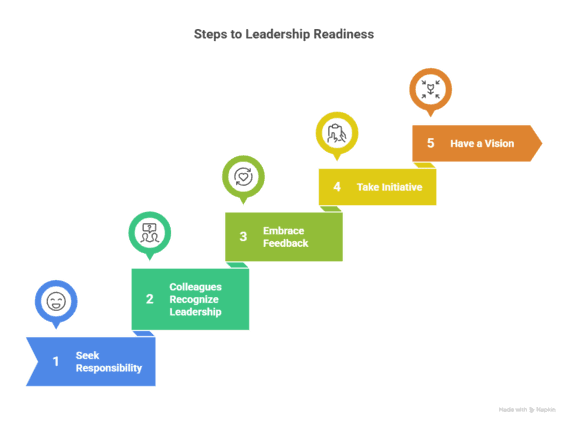5 Signs You’re Ready for a Leadership Potential Assessment

Stepping into a leadership role is a big move. How do you know if you’re truly ready to lead? The truth is, not everyone is a born leader – in fact, Gallup research reveals that only about 1 in 10 people have the natural talent to manage effectively. The good news is that leadership skills can be developed. A leadership potential assessment is one tool to evaluate your strengths and growth areas as a leader. (For a primer on how these assessments work and why they matter, see our Leadership Assessment Guide.) If the following signs sound familiar, it may be a signal that you’re ready to put your leadership potential to the test.

1. You Seek Greater Responsibility and Growth
Do you find yourself volunteering for new projects or asking for more responsibilities at work? A strong aspiration to lead is one of the clearest indicators of leadership potential. In fact, experts note that high-potential leaders typically demonstrate high levels of aspiration, ability, and engagement. Craving new challenges and feeling capable of more than your current role is a positive sign. You might feel bored or underutilized in your position because you know you can contribute at a higher level. This drive to grow and take on bigger challenges means you’re not content with the status quo – you’re preparing yourself for leadership opportunities.
Bold move: You actively seek out training, mentorship, or stretch assignments to develop your skills. Rather than waiting to be tapped on the shoulder, you’re raising your hand. This proactive mindset shows that you’re already thinking like a leader, which is exactly what a leadership assessment is designed to measure and encourage.
2. Colleagues Already See You as a Leader
Another sign you’re ready for a leadership assessment is when those around you recognize your leadership qualities – even if you don’t have the title yet. Perhaps you’ve noticed coworkers coming to you with questions or for guidance. You might be the go-to person on the team for advice or help with problems. If you enjoy this informal mentoring role and find it happening more frequently, that’s a strong indicator of budding leadership tempo.io. People trust your judgment and naturally gravitate toward you for support.
Here are a few behaviors you might recognize in yourself:
- Team members seek your input. You frequently have colleagues asking for your opinion on decisions or how to handle challenges. This shows they respect your insight.
- You step up in group settings. In meetings or projects, you often find yourself facilitating discussion, delegating tasks, or motivating the group – even if you weren’t officially asked to lead.
- You mentor others. You take newer or junior colleagues under your wing, offering to show them the ropes. Helping others succeed is something you genuinely enjoy.
When your peers already view you as an informal leader, it means you’re exhibiting the empathy, communication, and reliability people look for in a manager. An assessment can validate these qualities and highlight how you can leverage them even more in a formal leadership role.
3. You Embrace Feedback and Self-Improvement
Great leaders are lifelong learners. If you actively seek out feedback on your performance and constantly look for ways to improve, you’re displaying a level of self-awareness that is crucial for leadership. The better you understand your own strengths and weaknesses, the more effective you can be as a leader ccl.org. Do you ask your manager for constructive criticism, or solicit input from peers on how you handled a project? Do you reflect on setbacks to learn from them rather than blaming others? These habits show that you’re committed to continuous improvement.
In contrast to those who think leaders are simply “born,” you recognize that leadership is a skill you can build. (Leadership experts agree that good leaders are made, not born – they’re developed through experience, effort, and learning.) You might be investing time in reading leadership books, taking courses, or practicing new management techniques in your current role. This openness to growth is exactly what a leadership assessment rewards. It will give you nuanced feedback on your leadership competencies, which you can use as a roadmap for further development. In short, if you’re actively trying to better yourself as a leader, you’re likely ready to measure that progress with an assessment tool.
4. You Take Initiative and Own Your Results
Think about how you react when you see a problem or an opportunity at work. Do you wait for instructions, or do you jump in with solutions? Taking initiative is a hallmark of leadership readiness. High-potential individuals don’t just do what’s in their job description – they look for ways to contribute beyond it indeed.com. If you often find yourself saying, “I can handle that,” or implementing improvements without being asked, you’re acting like a leader.
Consider whether these scenarios sound like you:
- You’re proactive, not reactive. When an issue arises, you’re often the first to address it. Rather than waiting to be told what to do, you come forward with a plan.
- You volunteer for new challenges. If there’s a new project or task up for grabs, you raise your hand. Your willingness to step outside your comfort zone and take on responsibility shows confidence in your abilities.
- You own your responsibilities. When you commit to a task, you see it through and take responsibility for the outcome. If mistakes happen, you don’t point fingers – you learn from it and make it right. Leaders “own” their results in exactly this way, instead of needing to be micromanaged.
By consistently showing initiative and accountability, you demonstrate the mindset needed for leadership. A leadership potential assessment will likely highlight these traits – such as problem-solving, drive, and accountability – as some of your key strengths. It may also identify how you can channel them even more effectively when you have a formal leadership role.
5. You Have a Vision and Desire to Make an Impact
Perhaps the biggest sign that you’re ready for a leadership assessment is that you aren’t just thinking about your own tasks – you’re thinking big picture. True leaders have a vision for the future. They not only plan for their own success, but also consider what their team or organization could achieve down the road indeed.com. Do you often catch yourself brainstorming ways to improve processes, better serve customers, or grow the business? Do you care about the why behind your work and rally others around a shared goal? This sense of purpose and forward-thinking indicates you’re operating at a leadership level of mindset.
Leaders who make a lasting impact tend to be purpose-driven. They connect daily tasks to a larger mission, inspiring others by communicating that vision clearly. If you’re the person who says, “Imagine what we could accomplish if…”, then you’re already practicing this skill. You likely also show strong engagement in your work – going the extra mile because you’re invested in the outcome. (Highly engaged, visionary employees often turn out to be the best leaders in waiting.)
Having a vision and a desire to influence positive change suggests you’re ready to assess how prepared you are to turn that vision into reality. A leadership potential assessment can measure qualities like strategic thinking, influence, and commitment to goals – all critical for turning ideas into impact.
Ready to Take the Next Step?
Recognizing these signs in yourself is a great start. It means you have the raw material that leadership assessments look for. But remember, awareness is only step one. The next step is to validate and refine your leadership capabilities. If you’re nodding along to the signs above, consider taking our free leadership potential assessment. It’s a quick, research-backed way to gauge where you stand as an emerging leader. You’ll get insights into your strengths and areas for growth, so you can chart a clear path forward in your leadership journey.
Finally, don’t forget that developing as a leader is an ongoing process. Use the results of your assessment as a roadmap. Seek out opportunities, keep learning, and stay curious. With the right mindset and tools, you can evolve from someone with potential into an impactful leader. And if you want to dive deeper into how to leverage assessments and other development strategies, feel free to explore our complete guide to leadership assessments for more tips.
Your leadership journey is just beginning – and recognizing that you’re ready for it is a sign of great things to come. Good luck!
FAQ's
When should I take a leadership assessment?
Take one when preparing for promotion, hitting a career plateau, or lacking feedback. These are reliable indicators of readiness.
How is a leadership potential assessment different from a development assessment?
Potential assessments gauge readiness for bigger roles, while development assessments diagnose strengths and growth areas in your current role.
What are signs I might need leadership coaching instead of just an assessment?
If you feel stuck, lack direction, or need accountability to act on feedback, coaching can complement an assessment.

I’m an executive advisor and keynote speaker—but before all that, I was a tech CEO who learned leadership the hard way. For 16+ years I built companies from scratch, scaled teams across three continents, and navigated the collision of startup chaos and enterprise expectations.